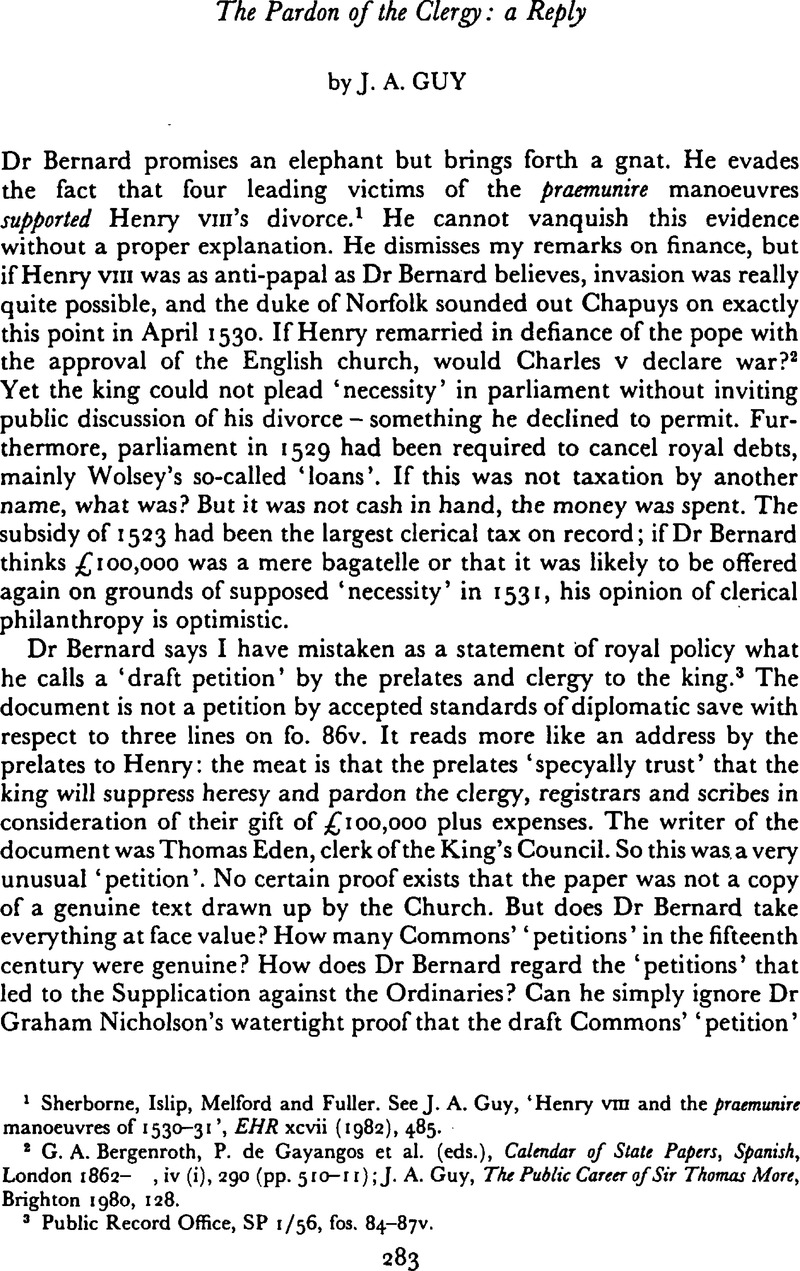No CrossRef data available.
Published online by Cambridge University Press: 25 March 2011

page 283 note 1 Sherborne, Islip, Melford and Fuller. See Guy, J. A., ‘Henry VIII and the praemunire manoeuvres of 1530-31’, EHR xcvii (1982), 485Google Scholar.
page 283 note 2 Bergenroth, G. A., Gayangos, P. de et al. (eds.), Calendar of State Papers, Spanish, London 1862, iv (i), 290 (pp. 510–11);Google ScholarGuy, J. A., The Public Career of Sir Thomas More, Brighton 1980, 128Google Scholar.
page 283 note 3 Public Record Office, SP 1/56, fos. 84-87V.
page 284 note 4 Nicholson, G. D., ‘The nature and function of historical argument in the Henrician Reformation’, unpublished Cambridge Ph.D. diss. 1977, 139–44.Google Scholar The ‘petition’ is BL, Cotton MS Cleopatra E. vi, fos. 274-5. Unlike SP1/56, fos. 84-87V it is not in the known hand of a royal clerk.
page 284 note 5 PRO, SP 2/N, fos. 155-62.
page 284 note 6 See , Guy, Public Career of Sir Thomas More, 181–3.Google Scholar
page 284 note 7 Baker, J. H. (ed.), The Reports of Sir John Spelman (Selden Society xciii-xciv, 1977-8) ii 395.Google Scholar
page 284 note 8 Elton, G. R., Policy and Police, Cambridge 1972, 265–7.Google Scholar The first formal composition between the Canterbury province and Henry VIII was dated 4 March 1531 (PRO, E 135/8/36).
page 284 note 9 , Guy, ‘Praemunire manoeuvres’, £495Google Scholar.
page 285 note 1 , Guy, ‘Praemunire manoeuvres’, 485.Google Scholar
page 285 note 2 PRO SPI/93/fo. 55 supplemented by SPI/93/fo. 59V (LP, VIII 859 (i), (ii)), cited by Scarisbrick, J. J., ‘The conservative episcopate’, 73Google Scholar.
page 285 note 3 The content and the tone of this document seem to me (and to Professor Lehmberg Lehmberg, S. E., The Reformation Parliament 1529-1536, Cambridge 1970, in n. 3)Google Scholar to show that it is a petition drawn up by the leaders of the Church, expressing their sincere concern at the spread of heresy and their worries about the Crown's attack on their jurisdiction. In referring to the king's earlier defence of the universal Church, it does also pointedly touch on the question of the royal supremacy.
page 285 note 4 Here Dr Guy has muddled up serjeants-at-law and king's Serjeants. Audley was called as a serjeant-at-law on 12 (not 14) November 1531. (Baker, J. H., ed., The Reports of Sir John Spelman (Selden Society xciii-xciv, 1978 for 1977) i. 79)Google Scholar Serjeants-at-law were chosen.